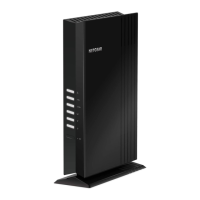
Do you have a question about the NETGEAR EAX20 and is the answer not in the manual?
| Type | Network repeater |
|---|---|
| WPS push button | Yes |
| Ethernet LAN data rates | 10, 100, 1000 Mbit/s |
| Maximum transfer distance | - m |
| Package type | Box |
| Package depth | 290 mm |
| Package width | 210 mm |
| Package height | 110 mm |
| Package weight | 990 g |
| Master (outer) case width | 242 mm |
| Master (outer) case height | 380 mm |
| Master (outer) case length | 477 mm |
| Master (outer) case weight | 5370 g |
| Quantity per master (outer) case | 4 pc(s) |
| Modulation | 1024-QAM |
| Wi-Fi band | Dual-band (2.4 GHz / 5 GHz) |
| Cabling technology | 10/100/1000Base-T(X) |
| Security algorithms | 128-bit AES, WPA-PSK |
| Networking standards | IEEE 802.11a, IEEE 802.11ac, IEEE 802.11ax, IEEE 802.11b, IEEE 802.11g, IEEE 802.11k, IEEE 802.11n |
| Ethernet LAN (RJ-45) ports | 4 |
| Product color | Black |
| Depth | 169.5 mm |
|---|---|
| Width | 241.7 mm |
| Height | 63.4 mm |
| Weight | 504.5 g |
Details on what comes in the extender package, including the extender and power adapter.
Explains the status indicators (LEDs) on the front panel of the extender.
Describes the components located on the back panel of the extender, such as the reset button and ports.
Lists the necessary hardware and software requirements for installing the WiFi extender.
Explains the fundamental principles and functions of the WiFi range extender.
Provides instructions on how to install the WiFi extender for the first time.
Guides users on selecting an optimal location and powering on the WiFi extender.
Details the process of connecting the extender to your current WiFi network.
Explains how to use the NETGEAR Nighthawk app for extender setup and connection.
Describes how to use the Wi-Fi Protected Setup (WPS) feature for connecting the extender.
Outlines the steps to use the web browser-based NETGEAR installation assistant.
Instructions for configuring the extender to function as a WiFi access point.
How to connect your devices (computers, phones) to the extender's network.
Steps to access the extender's settings interface after initial setup.
Guide on using the Smart Setup feature for easy configuration and connection.
How to manage the feature that uses a single WiFi network name for router and extender.
Instructions for enabling or disabling the Smart Connect feature for optimal band selection.
How to see a list of all devices currently connected to the extender's network.
Steps to access and review the current WiFi configuration settings of the extender.
Procedure for modifying the SSID (network name) for the extender's WiFi.
Guide on hiding the extender's WiFi network name (SSID) broadcast.
Instructions on turning the extender's 2.4 GHz and 5 GHz WiFi radios on or off.
How to adjust or understand WiFi speed settings based on backhaul connection.
Steps to connect devices to the extender's network using the WPS method.
Detailed guide for using the physical or on-screen WPS button for connection.
Instructions for connecting devices to the extender using the WPS PIN method.
How to block specific devices from accessing the extender's network using MAC addresses.
Procedure for creating schedules to control network access for users.
How to rename the extender in the network interface.
Guide on configuring a fixed IP address for the extender instead of a dynamic one.
Instructions for activating FastLane to improve HD entertainment performance.
How to adjust router MAC settings for compatibility with the extender.
Steps to modify the credentials used to log into the extender's web interface.
How to enable or disable password protection for the extender's web interface.
Procedure for recovering lost login credentials using security questions.
How to set the extender to automatically adjust its clock for daylight saving time.
Instructions for manually setting the date and time on the extender.
Overview of backing up and managing the extender's configuration settings.
Detailed steps to create a backup of the extender's current configuration.
How to load a previously saved configuration file to restore settings.
Instructions for resetting the extender to its original factory settings.
Guide on using the physical reset button to restore factory default settings.
Steps to log in and reset the extender to factory defaults via the web interface.
How to check for and install new firmware updates for the extender.
Procedure for manually checking and applying available firmware updates.
Instructions for uploading a firmware file from a computer to the extender.
How to reboot the extender using its web-based management interface.
Steps to control the power and status lights (LEDs) on the extender.
Answers to frequently asked questions about the extender's operation and setup.
Guide on locating the extender's IP address, often through the router's interface.
Troubleshooting steps for when you are unable to establish a connection with the extender.
Solutions for issues encountered when trying to connect the extender to a WiFi network.
Troubleshooting tips for when the extender's web interface is inaccessible.
Solutions for problems encountered when using the Nighthawk app to connect to the extender.
Lists the default configuration settings of the extender upon factory reset.
Provides detailed technical and environmental specifications for the extender.